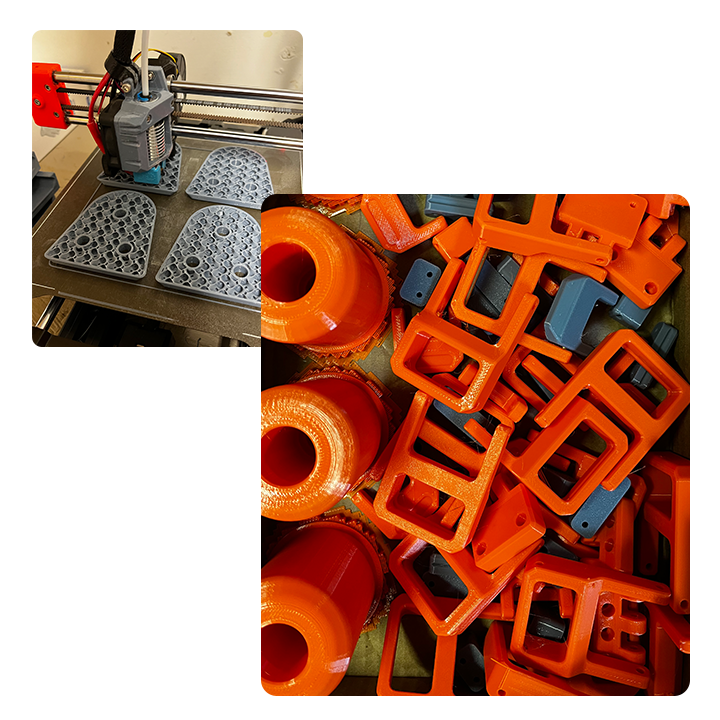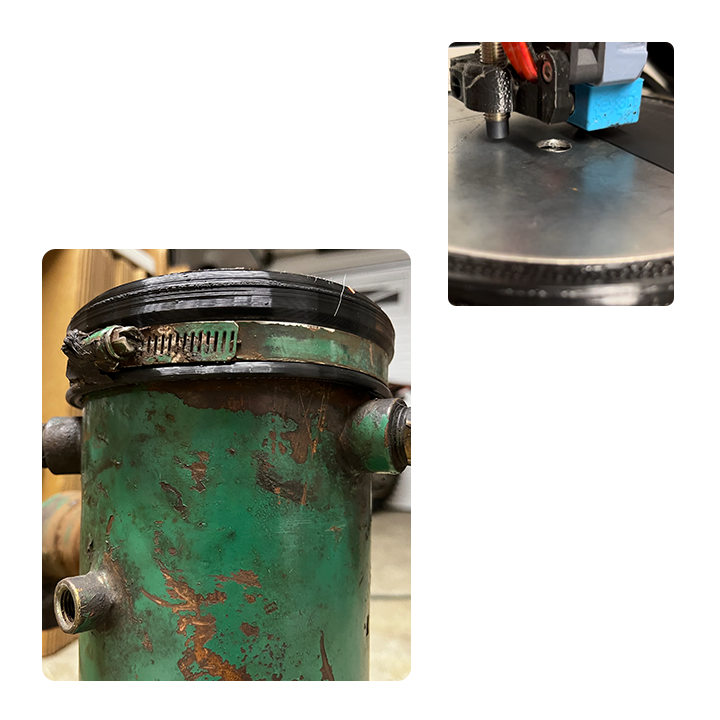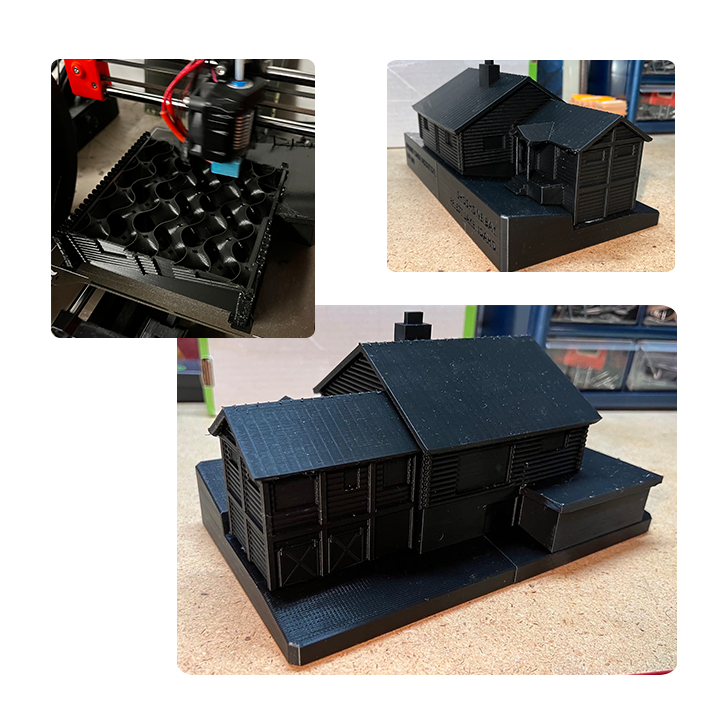We offer quick turnarounds at an affordable price.
De-risk your product testing and utilize the advantages of production 3D printing to release your next idea. With a fully automated facility, Raido Product Development can produce complex models in a variety of materials at up to 2,000 parts per week on demand or in high quantities. Remove the time and cost out of production tooling and discover the advantages of production 3D printing for your needs.
We offer rapid quoting services to streamline your production 3D printing needs. Curious on pricing?
The 3D printing advantage.
The problem:
3D Printing, also known as additive manufacturing, has often been associated with low quantity part production. Recently, manufacturing services have offered the ability to create 3D Printed parts as part of their rapid prototyping service where customers will receive parts in less than 2 weeks. Although, this comes at a cost and they do not support higher quantity production.
On the other end of plastics production is injection molding. This process is typically used for very high part production and although the price per part is very affordable, when the cost of tooling is amortized over price per part, it is not as appealing until part quantities of 10,000+. In addition, it takes on average 8-12 weeks to produce, test, and run an injection mold!
Here is where we fit in:
With production 3D printing, we utilize our large portfolio of 3D printers in order to harness the advantages of 3D printing, while still being able to bypass the upfront costs of injection molding and meet the quantity needs of the customer in a timeline that is faster than getting an injection molding tool in to production.
Processes that fit your timeline.
Printer Profile
Time
+/-0%
+8%
+15%
+4%
-7%
+19%
+/-0%
+120%
+158%
+246%
+95%
+207%
BLACK, GREY
BLACK, GREY
BLACK, GREY
BLACK, GREY
BLACK, GREY
BLACK, GREY
BLACK, GREY
BLACK, GREY
BLACK
BLACK
BLACK
BLACK
+90%
+/-0%
-30%
Materials at an affordable cost.
Available Color(s)
Material
Cost
For all profile types:
Our build volume is 300x300x300mm (11.8x11.8x11.8in)
A global part profile tolerance of +/- 0.254mm (0.01in) for Detail and Standard profiles and +/- 0.35mm (0.014in) for the Speed profile, both with an angular tolerance of +/- 0.5 degrees.
Special colors available on request except for PA6/6.6, PA6-CF, PP, and PC-ABS materials.
We dry all filaments for at least 8 hours before using. This ensures no boiling occurs in the printer nozzle and as a result, creates a stronger and higher quality part.
Additional post-processing options such as thread inserts, tapped holes, and precision holes are available. Please see the Post-Processing section on this page.
Click on a printer profile or material type to see how they compare visually. Not sure what process or material to choose? Contact us for a recommendation and we will get back to you within 24 hours.
Material Guide
-
Polylactic Acid (PLA) is one of the most popular materials used in 3D printing. It is inexpensive and can create parts for a wide variety of applications. It is also very environmentally friendly as it is derived from crops and makes it renewable and biodegradable.
Pros
Low cost
High stiffness
Dimensional Accuracy
Surface finish
Cons
Low heat resistance
More brittle than other materials
Not suitable for outdoors or UV exposure
Applications
Prototypes for test-fitting and calibration
Decorative parts
Small-load components
-
PETG is a Glycol Modified version of Polyethylene Terephthalate (PET), which is commonly used to manufacture water bottles. It is a semi-rigid material with good impact resistance, but it has a slightly softer surface which makes it prone to wear. The material also benefits from great thermal characteristics.
Pros
Glossy, smooth surface finish
Little to no warping of part
Higher heat resistance and mechanical properties compared to PLA
Cons
Can require post-processing to remove filament hairs from the part surface
More visible layer lines due to the glossy surface
Applications
Waterproof components
Snap-fit parts
Structural plastic components
-
ABS (Acrylonitrile Butadiene Styrene) has a long history in the 3D printing world. This material was one of the first plastics to be used with industrial 3D printers. ABS is known for its toughness and impact resistance, allowing you to print durable parts that will hold up to extra usage and wear. LEGO building blocks are made from this material.
Pros
Low cost
Good impact and wear resistance
Good heat resistance
Cons
Parts can shrink leading to dimensional inaccuracies
Applications
Household items
Car parts
Toys
-
ASA is known for high impact resistance, higher temperature resistance, and increased printing difficulty. It’s commonly used in outdoor applications instead of ABS due to its superior resistance to UV and harsh weather conditions.
Pros
High impact and wear resistance
Strong UV resistance
High glass transition temperature
Cons
More expensive than ABS
Applications
Sunglasses
Outdoor tools
-
Flexible filaments are made of Thermoplastic Elastomers (TPE) which are a blend of hard plastic and rubber.
Pros
Flexible and soft
Vibration dampening
Good impact resistance
Cons
Longer print times
Overhangs and detailed geometries are more difficult to print
Higher chances of part stringing
Applications
Grips
Bumpers
Elastic components
Dog toys
-
This hybrid nylon material provides the upsides of materials like ABS, but with added flexibility leading to a strong, yet tough part that can deflect under loads without fractures.
Pros
Good abrasion resistance
Tough and partially flexible
High impact resistance
Cons
Not suitable for moist and humid environments
Applications
Cable ties
Gears
Nuts & bolts
-
The highest performing material we offer. All the benefits of nylon with additional strength from 20% of the composition being chopped carbon fiber. Carbon fiber filaments use tiny fibers that are infused into a base material to improve the properties of that material. These fibers are extremely strong and cause the filament to increase in strength and stiffness. This also means that the 3D printed parts will be much lighter and more dimensionally stable.
Pros
Increased strength and stiffness over unfilled nylon filaments
Dimensional accuracy
Good strength to weight ration
Cons
More brittle than standard unfilled nylon filaments
Not suitable for moist and humid environments
High cost
Applications
Frames
Linkages
Automotive parts
-
With print quality comparable to PLA, this polycarbonate (PC) and ABS blend is a high strength material intended for tough environments and engineering applications. It has extremely high heat deflection, and impact resistance. Polycarbonate also has a high glass transition temperature of 150° Celsius. This means it will maintain its structural integrity up to that temperature, making it suitable for use in high-temperature applications. It can also be bent without breaking and is often used in applications where some minor flexibility is required.
Pros
Superior impact resistance
High heat resistance
Good flexibility
Cons
High cost
More brittle than nylon filaments
Applications
High-impact equipment
High-heat applications
-
Polypropylene is a semi-rigid and lightweight material that is commonly used in storage and packaging applications. Polypropylene is tough and has a good fatigue resistance making it ideal for low strength applications like living hinges, straps, leashes, etc.
Pros
Good impact and fatigue resistance
Good heat resistance
Smooth surface finish
Cons
Higher cost
Now as strong as other options
Applications
Storage containers
Straps
Semi-flexible objects
Special colors available on request except for PA6/6.6, PA6-CF, PP, and PC-ABS materials. Need information on material properties? Please contact us to receive a datasheet.
For a more in depth look at how materials stack up, a detailed comparison can be found here.
Post Processing Options
-
We provide the following brass thread insert options for an additional cost per thread. It is recommended to have at least 2mm of added hole depth relative to the length of the thread insert (noted below). In addition, thread inserts should be placed at least 10mm apart from the hole center with a 0.5mm near-side countersink.
M2x0.4 | D: 3.5mm | L: 3,4,6,8mm
M3x0.5 | D: 5mm | L: 6,8,10mm
M4x0.7 | D: 6mm | L: 6,8,10mm
M5x0.8 | D: 7mm | L: 6,8,10mm
M6x1.0 | D: 7.5mm | L: 10,12mm
-
We will tap any hole that is >= 4mm (0.157in) at any pitch coarser than 0.5mm (50TPI). Please follow the standard tap hole size for design based on the standard used (ANSI, ISO, etc.)
-
Looking for a tighter tolerance hole for your project? We provide drilling and reaming services to create precision holes down to +/- 0.0254mm (0.001in) in diameter.
Utilizing the 3D printing advantage.
Frequently Asked Questions
Questions on how to design for our 3D printing process? We have you covered! Below are a list of commonly asked questions that will help in your search. For unique inquiries, please contact us and we will get back to you within 24 hours.
-
Our printers support a maximum part size of 180x180x180mm, or 7x7x7in. If high production needs are required for a part of a larger size, please reach out and we can discuss how to optimize the model to better fit our facility’s constraints.
-
We recommend our customers design around a +/- 0.254mm (0.010in) tolerance band for Detail and Standard profiles with a +/- 0.35 (0.014in) tolerance band for our Speed profile. Both have a global angular tolerance of +/- 0.5 degrees. Tighter tolerances can be achieved for certain geometries such as holes. Please see the Post Processing Options section of this page for more details.
-
Although 3D printing does offer much simpler design constraints than other manufacturing processes, there are still general rules that should be considered. A great design guide we like to follow is at the link below:
https://www.hubs.com/knowledge-base/how-design-parts-fdm-3d-printing/
-
We are constantly proving out new materials and colors on our printers. If there is a color or material that you do not see listed, please do not hesitate to reach out so we can make the proper accommodations for your project!
-
Part geometry, production speed, and quantity are typically the 3 factors that affect this decision. At Raido Product Development, if there is a different process that better suits your goals, we will point you in the right direction. There are some times where parts simply need a different process to be manufactured. A great example is plastic sheets, a geometry much better suited for casting or extrusion processes. Similarly explained in the “3D printing advantage” section of this page, there is also a point where the volume needs no longer suit 3D printing.







